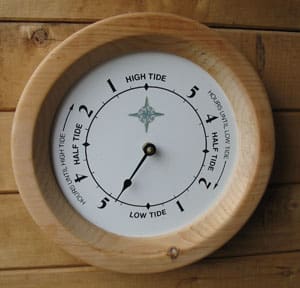In the small village where I live, I have spread my reputation as someone who knows a thing or two about celestial navigation. As a result, once every couple of years I get a call from some poor soul who is totally lost in the celestial triangle. I do my best to dispel the confusion, usually succeeding in either clarifying the problem or dispatching information so obtuse that the caller immediately gives up.
So it was last week that another one of these calls came. The caller, someone I think I know, but I’m not certain, had just purchased a fancy yachting watch that included a tide program in its myriad functions. The caller was totally befuddled as to how to calibrate the tide table on his watch. The instructions, written in four languages, advised the purchaser to enter the lunitidal interval in order to calibrate the tide program. So I was asked, what is the lunitidal interval and how is it found?
I admit, ruefully so, that I hadn’t the foggiest notion of what he was talking about. I know something of the tides — the fact that every day the high tide is 50 minutes later than the day before, the difference between spring and neap tides, and that the interval between two high tides on the same day is 12 hours and 25 minutes. But much to my chagrin, I had never heard of the lunitidal interval. I went to all my navigation books and searched the Internet and learned something new, which I can now share with you. I am certain that most of you already know what I am speaking of, but indulge me.
The lunitidal interval is the difference in the average time of the meridian passage of the moon and the following high tide. Theoretically speaking, the time of the meridian passage of the moon at a specific location should equal the maximal gravitational effect of the moon and should be the same time as the high tide in that location. But — and this is a big but — there is a lag due to other forces in play, including the topographic shape of the seabed and the coast, that create a time lag. This is information that I did not know and, short of the requirement called for by setting a watch, I had no idea why it would be of value, except for it being simply interesting.
The first thing to do is to find the time of the upper meridian passage of the moon. It is best to use a date when the moon is either full or new — in other words, a date that equates with spring tides. Here I turn to the trusty Nautical Almanac, as the meridian passage of the moon is listed in the daily pages. It is, of course, noted in local mean time. There is no need here to fine-tune the exact longitude and convert to GMT. We will be working in local time. We can also find the time of meridian passage by getting the time of moonrise and moonset and dividing by 2.
Next, we need a tide table for our area and we need to notate the time of the next high tide following the meridian passage. We then subtract one from the other and the result is the lunitidal interval.
On Jan. 28, there is a new moon. At my location in Greenport, Long Island, high tide for that day is at 1037 and 2313. Going to the Nautical Almanac (2017 edition), I see on the daily pages in the lower right-hand corner that the upper meridian passage of the moon is at 1236 LMT. By the way, it is also interesting to note that the meridian passage of the sun that day is 1213. This makes perfect sense, as the moon is following the sun by about 20 minutes.
So on Jan. 28, meridian passage of the moon is at 1236. The next high tide is at 2313. If I subtract the meridian passage time from the following time of high tide, I get 10 hours and 37 minutes. This means that the lunitidal interval — in other words, the difference in time between the meridian passage of the moon and high tide — is 10 hours and 37 minutes. The more accurate method of finding the lunitidal interval is to take an average time of meridian passages at a full or new moon and then average the following high tides for those dates. The implications of this information are interesting. If one knows the lunitidal interval for a specific area, then the time of high tide and low tide can be approximated should one not have a tide table.
My caller, by the way, got back to me a week later and I explained what I had learned. He listened politely and then told me that it didn’t matter anymore as he had sent the watch back.

